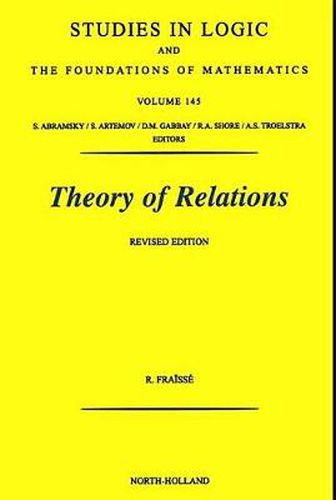Readings Newsletter
Become a Readings Member to make your shopping experience even easier.
Sign in or sign up for free!
You’re not far away from qualifying for FREE standard shipping within Australia
You’ve qualified for FREE standard shipping within Australia
The cart is loading…






Relation theory originates with Hausdorff (Mengenlehre 1914) and Sierpinski (Nombres transfinis, 1928) with the study of order types, specially among chains = total orders = linear orders. After exploring initial problems and solutions, the text goes on to discuss the general theory of relations, with the notions of local isomorphism, free interpretability and free operator (9.1 to 9.3), which is the relationist version of a free logical formula. This is generalized by the back-and-forth notions in 10.10: the (k,p)-operator is the relationist version of the elementary formula (first order formula with equality). The book then connects relation theory with permutations: theorem of the increasing number of orbits. Homogeneity is introduced, then more deeply studied in the appendix written by Norbert Saucer. Relation theory is connected with finite permutation groups, and also mentioned are the extensions to relations of adjacent elements, giving an exact calculus of the reduction threshold. The book covers almost all knowledge in relation theory, with all results exposed in axiomatic set theory.
$9.00 standard shipping within Australia
FREE standard shipping within Australia for orders over $100.00
Express & International shipping calculated at checkout
Relation theory originates with Hausdorff (Mengenlehre 1914) and Sierpinski (Nombres transfinis, 1928) with the study of order types, specially among chains = total orders = linear orders. After exploring initial problems and solutions, the text goes on to discuss the general theory of relations, with the notions of local isomorphism, free interpretability and free operator (9.1 to 9.3), which is the relationist version of a free logical formula. This is generalized by the back-and-forth notions in 10.10: the (k,p)-operator is the relationist version of the elementary formula (first order formula with equality). The book then connects relation theory with permutations: theorem of the increasing number of orbits. Homogeneity is introduced, then more deeply studied in the appendix written by Norbert Saucer. Relation theory is connected with finite permutation groups, and also mentioned are the extensions to relations of adjacent elements, giving an exact calculus of the reduction threshold. The book covers almost all knowledge in relation theory, with all results exposed in axiomatic set theory.